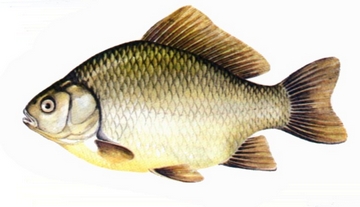The Crucian Carpposted on 8 February 2015 | posted in Hints and TipsCommon name: Crucian carp Latin name: Carassius carassius  Record weight: Despite several fish being accepted and then dropped from the record list because of miss-identification, the current record of 4lb 8oz caught by Jay Allen from RMC Angling's Summer pit is a fully authenticated record. Distribution: The crucian is amongst the most contentious of all our fishes. Anybody who believes they can identify them easily is either a charlatan, or deluded, for this species not only easily hybridises with both carp and the closely related brown goldfish, but can also be easily confused with the brown goldfish. For this reason, it is difficult to determine the actual distribution of this species in the UK. At best, it is limited and perhaps in decline thanks to hybridisation. In Europe it is found through Scandinavia to isolated (introduced) populations in the Rio Ebro in Spain. Features: Dark golden bronze colouration makes the crucian an impressive looking fish. An absence of barbules is a clear and easily defined difference between it and small common carp. Look for a lateral line count of between 31-26 and convex dorsal fin and a weak leading ray to the dorsal fin as hints to identification, although many of these features will be shared with hybrids. Diet: Despite being a member of the carp family, crucians are much more delicate feeders than their larger cousins. This is in part because of their definite preference for tiny invertebrates, particularly chironomid larvae. Larger fish will take a range of invertebrates including small molluscs and freshwater shrimps when available. Spawning: Crucians spawn in very warm conditions found between May and August. In the UK, spawning may only take place infrequently. The ideal habitat for crucians is small farm ponds and oxbow lakes where the harsh conditions do not suit larger species that would adversely compete with these small fish. Crucians are particularly adapted to high temperatures and low oxygen concentrations and can survive in tiny ponds that become very warm. Paradoxically, these harsh environments lead to good survival of young crucians and small pond populations are often made up of huge numbers of stunted individuals. Growth: Crucians are a slow growing species. The fish mature after only 3-4 years at a weight of only half a pound. When they are not stunted, crucians can live for around fifteen years and will slowly grow to a couple of pounds in weight. Fish of more than two pounds are generally very rare. In stunted populations each fish may weigh only a few ounces, but will be sexually mature and each year will produce more offspring propagating the stunted population. |








.jpg)
.jpg)





